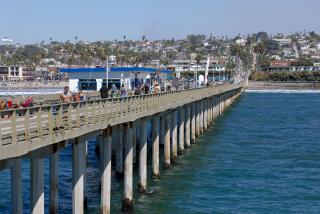Experts Fault Repairs to New Orleans Levees
- Share via
A dispute over the safety of levee repairs in New Orleans intensified Tuesday, when the head of an academic team investigating levee failures during Hurricane Katrina said the repairs being overseen by the Army Corps of Engineers were flawed.
The corps is not paying adequate attention to the technical concerns the team is raising, Raymond B. Seed, a UC Berkeley professor, said in a letter Tuesday to the corps commander.
The issue involves the team’s findings that the corps is using weak sand -- which would quickly erode in storms -- to rebuild about 12 miles of damaged levees just outside New Orleans on a shipping channel known as the Mississippi River Gulf Outlet.
“A growing chorus of experts are trying to tell you that there may be some significant concerns with regard to the material being placed along” the gulf outlet, Seed said in the letter to Lt. Gen. Carl Strock, the corps’ chief of engineers.
Corps officials disputed those conclusions Tuesday, saying the repaired levees would be taller and stronger than they were before Katrina struck.
The levees were badly damaged or destroyed in many sections by Katrina’s storm surge. The waters eventually inundated St. Bernard Parish and parts of the Lower 9th Ward of New Orleans.
The UC Berkeley experts, sponsored by the National Science Foundation, inspected the repair operations in early January, collecting samples of material used to rebuild the earthen barriers. Lab tests confirmed they would be “highly erodible” in a storm, Seed’s letter said.
The letter described some fill material as being so full of moisture that it had the consistency of toothpaste and that it was squeezing out from the tracks of bulldozers trying to compact it in one repair operation.
Robert G. Bea, a UC Berkeley professor who is also part of the investigation team, said in an interview that the newly repaired levees might be so weak that they would be virtually worthless in stopping a hurricane surge when the storm season starts June 1.
Bea said the National Science Foundation investigation had found evidence that the levees protecting St. Bernard Parish might have failed before the full brunt of Katrina struck the coastline, the result of waves pounding the weak sandy fill material in the levees. Until now, it was thought those levees failed because the surge ran over their tops.
If such a theory is confirmed, it would further undermine the corps’ “act of God” defense that the storm was bigger than they had designed for, Bea said. “The corps continues to hold onto the hope that this was an act of God, not an engineering failure,” he said.
Bea said corps officials in New Orleans were struggling to meet unrealistic demands from Washington superiors that all damaged levees be repaired by June 1. Federal officials who encourage residents to return to the flooded areas because they will be protected by the levees are engaging in “dangerous concealment” of the flaws, Bea said.
Corps engineers disagreed. “We feel we are doing adequate quality assurance and quality control in the field,” said Walter Baumy, deputy chief for the corps’ repair program. “We expect to have good levees.”
Baumy said the corps was stepping up importation of clay fill material from Mississippi to help reinforce the sandy fill being used to rebuild the levees. He said the corps also planned to encapsulate the levees in an outer layer of clay to help resist erosion.
It has not decided how thick a layer of outside clay will be placed on the levees, he said. Baumy said the Corps did not have the authority to further strengthen the levees with concrete, heavy rocks or other materials, a safety feature known as armoring.
Bea described the current plan as “putting frosting on a weak cake” and said a thin layer of clay would crack apart as it dried. Only substantial layers of clay, concrete coatings and other types of reinforcements would provide sufficient strength, he said.
More to Read
Sign up for Essential California
The most important California stories and recommendations in your inbox every morning.
You may occasionally receive promotional content from the Los Angeles Times.














